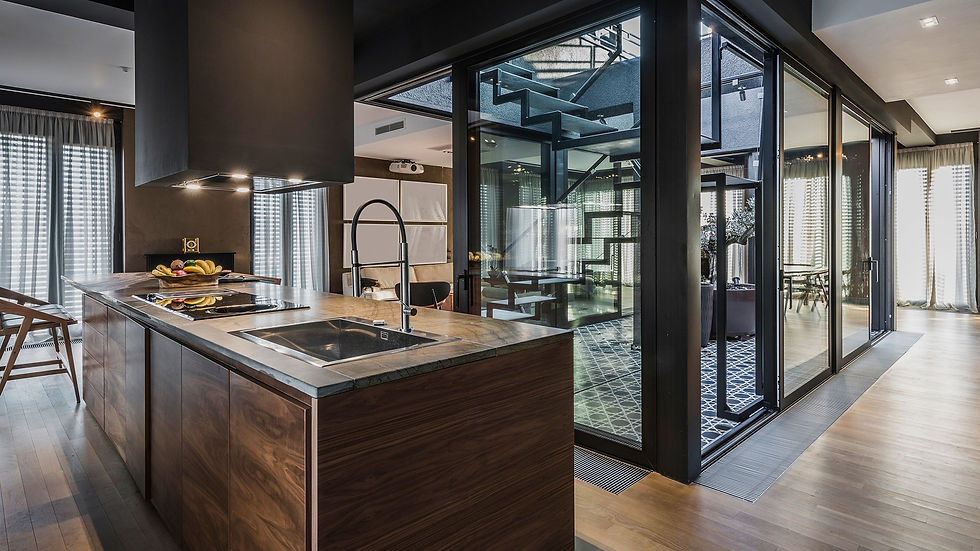Exploring Green Walls and Vertical Gardens Inside Your Home: The Benefits of Green Walls
- BLOU INK

- Feb 10
- 4 min read
Updated: Nov 19
Evolving into a world of healthier interior spaces, incorporating the benefits of green walls and vertical gardens is one step to bringing the outdoors in.

What Are Green Walls and Vertical Gardens?
Green walls, often referred to as 'living walls', are self-sufficient vertical gardens attached to the interior or exterior walls of a building. They consist of various plants that grow vertically, using hydroponics, and can thrive without soil.
Vertical gardens, on the other hand, generally require more traditional planting methods and can be free-standing or attached to walls. They can host a variety of plant life, from lush foliage to blooming flowers and even edible herbs and vegetables.

Green Walls and Improved Air Quality
One of the Benefits of Green Walls and vertical gardens is the improvement they bring to your indoor air quality. Plants are natural air purifiers; they absorb harmful toxins, release oxygen, and increase humidity. This process can help to reduce common pollutants, leading to a healthier and more comfortable living environment.
The Benefits of Green Walls onPsychological and Physical Health
Connecting with nature, even in small ways, can have a profound effect on our well-being. The inclusion of green walls and vertical gardens in our homes can reduce stress, enhance mood, and improve concentration and productivity. Additionally, the increased humidity provided by these installations can reduce dry skin, cold symptoms, and dry eyes.
Energy Efficiency and Noise Reduction
Green walls and vertical gardens offer excellent thermal insulation. During the warmer months, they can naturally cool the environment, reducing reliance on air conditioning. Similarly, in colder months, they can provide additional insulation, reducing heat loss and energy consumption.
Green vertical installations can also help with noise reduction. They can absorb high-frequency sounds and can be particularly effective in apartments or homes in noisy urban environments.
Aesthetics and Space Saving
There's no denying that green walls and vertical gardens add a striking aesthetic value to your home. They can transform an ordinary wall into a stunning, living piece of art, bringing life, color, and texture to your space.
Moreover, these installations are perfect for small living spaces. With housing footprints shrinking, particularly in urban areas, vertical gardens provide an excellent solution to incorporate greenery without sacrificing precious floor space.
Promote Biodiversity
From a sustainability perspective, green walls and vertical gardens promote biodiversity, even in urban settings. They provide a habitat for various flora that might not otherwise thrive in an indoor environment. Furthermore, if you choose to plant edibles, you can reduce your food's carbon footprint by growing your own herbs or vegetables.
Best Plants for Green Walls and Vertical Gardens
Choosing the right plants for your vertical wall or green wall primarily depends on the location and environmental conditions such as light, humidity, and temperature. However, there are several plant species well-known for their adaptability to vertical living. Here are some of the best plants that are commonly used in vertical gardens

Ferns
Various species of ferns are excellent choices for vertical gardens. They thrive in lower light conditions and bring a beautiful, lush green texture. Boston ferns and Maidenhair ferns are particularly popular choices.
Pothos (Epipremnum aureum)
Also known as Devil's Ivy, Pothos is a hardy vine with a reputation for being nearly impossible to kill. It can thrive in a variety of lighting conditions and looks beautiful cascading down a green wall.

Philodendrons
With their heart-shaped leaves and trailing vines, philodendrons are an excellent choice for vertical gardens. They are easy to care for and can handle a variety of light conditions.
Spider Plant (Chlorophytum comosum)
Spider plants are extremely adaptable and easy to grow, making them perfect for vertical gardens. They can tolerate a wide range of conditions, although they prefer bright, indirect light.

English Ivy (Hedera helix)
English Ivy is a classic choice for vertical gardens with its attractive trailing vines. It prefers indirect light and a regular watering schedule.
Succulents
There are many types of succulents, such as Sedum morganianum (Burro's Tail) and Echeveria, that can thrive in a vertical garden. They're a great choice if your vertical garden is in a spot that gets a lot of light.

Air Plants (Tillandsia)
Air plants don't need soil to grow, making them perfect for vertical walls. They come in various shapes and sizes, and their unique look can add an interesting aesthetic to your vertical garden.
Edible Plants
Various herbs like basil, mint, and parsley, as well as leafy greens like lettuce and spinach, can do well in a vertical garden and have the added bonus of being edible.
Incorporating a green wall or vertical garden into your home design is a step towards a more sustainable and healthier lifestyle. As we spend more time indoors, creating a home that promotes wellness, sustainability, and connection to nature has never been more essential. Green walls and vertical gardens are set to revolutionize our living spaces, one wall at a time.





Comments